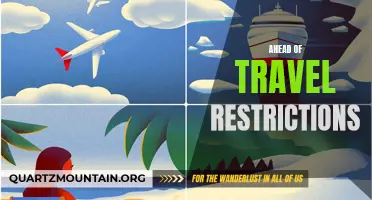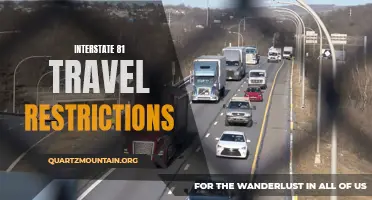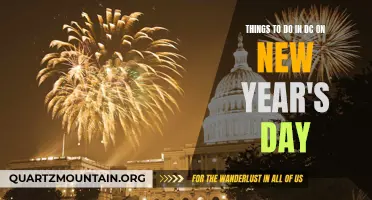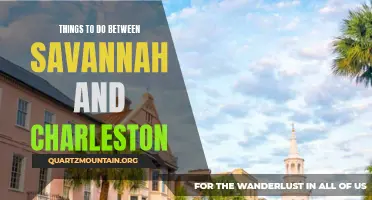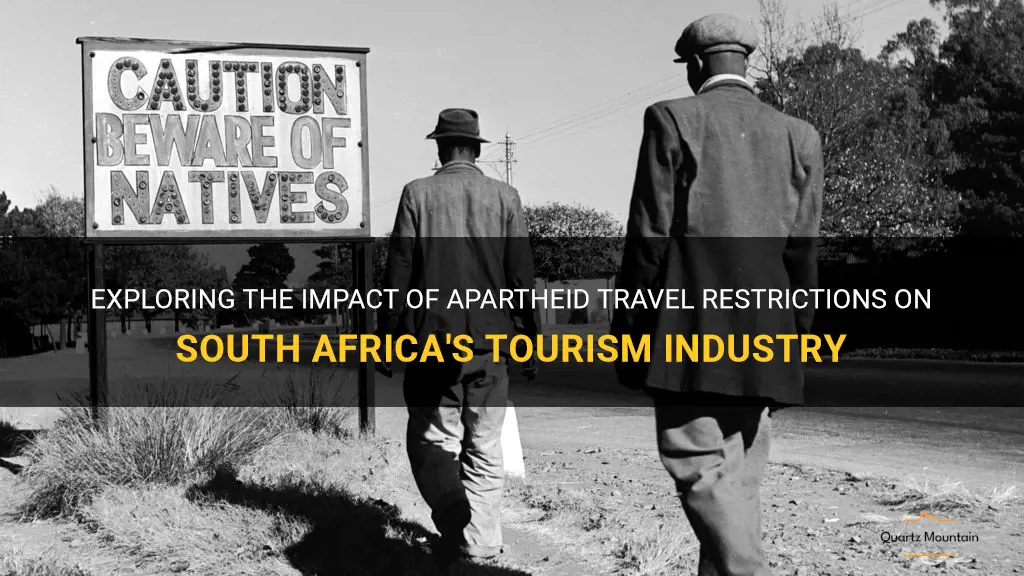
Apartheid travel restrictions were a defining aspect of the oppressive regime that existed in South Africa from the 1940s to the 1990s. These restrictions severely limited the movement and freedoms of the non-white population, enforcing a system of racial segregation and discrimination. The implementation of these restrictions not only had a profound impact on the daily lives of South Africans, but also shaped the country's history and identity. This essay will explore the apartheid travel restrictions and their implications, shedding light on a dark period in South Africa's past.
| Characteristics | Values |
|---|---|
| Time Period | 1948 - 1994 |
| Travel Restrictions | Widespread travel restrictions for non-whites both within and outside South Africa. Non-whites were required to carry passes and obtain permits to travel to designated areas. |
| Pass Laws | Pass laws enforced strict segregation and determined where non-whites were allowed to live and work. |
| Bantustans | Non-whites were forcibly moved into designated areas called Bantustans to separate them from white areas. |
| Separate Amenities | Non-whites were only allowed to use separate amenities and facilities such as schools, hospitals, parks, and public transportation. |
| Prohibition of Mixed Marriages | Marriages between different races were prohibited. |
| Group Areas Act | Forced racial segregation of residential areas, with specified areas for different racial groups. |
| Influx Control | Non-whites were restricted from moving to urban areas without express permission. |
| Job Reservation | Certain jobs were reserved for specific racial groups, limiting opportunities for non-whites. |
| Education | Non-whites had separate and unequal education systems, with limited resources and opportunities. |
What You'll Learn
- What were the specific travel restrictions implemented during apartheid in South Africa?
- How did these restrictions impact the lives and mobility of non-white South Africans?
- Were there any exceptions or loopholes to these travel restrictions for certain groups or individuals?
- How did international tourism react to the travel restrictions during apartheid in South Africa?
- Is there any evidence to suggest that the travel restrictions during apartheid were effective in achieving their intended goals?

What were the specific travel restrictions implemented during apartheid in South Africa?
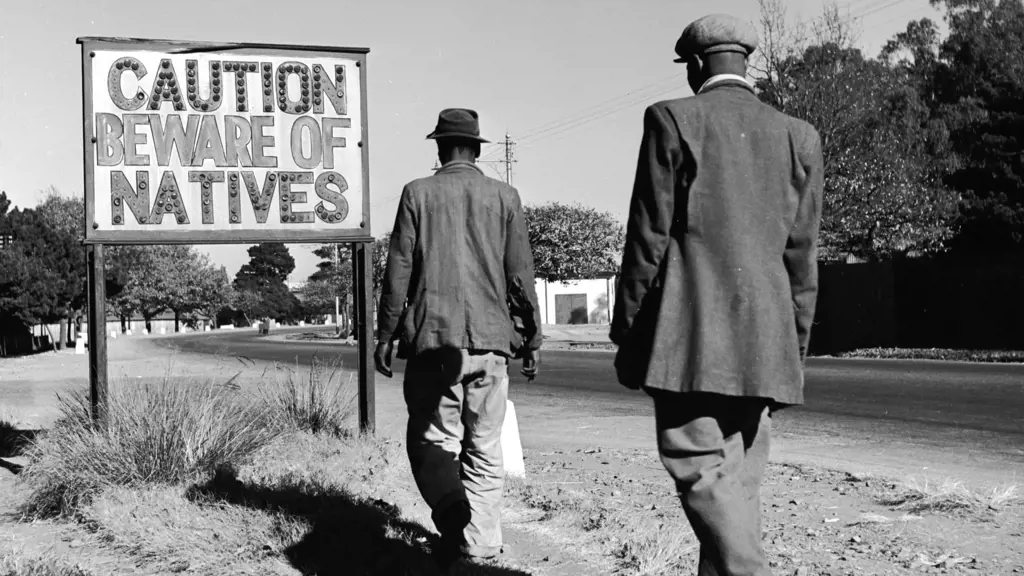
South Africa's apartheid regime implemented a strict system of travel restrictions that aimed to control the movement of its population, particularly the non-white population. These restrictions were a key aspect of the government's policy of racial segregation and discrimination.
Under apartheid, South Africa was divided into different regions based on race: white, colored (mixed-race), Indian, and black. Each racial group was assigned to specific areas known as "homelands" or "Bantustans," which were designated for their respective racial group. The government implemented various travel restrictions to enforce this segregation and maintain control over the movement of people.
One of the major travel restrictions imposed during apartheid was the requirement of a "passbook" or "dompas" for non-whites. This passbook contained personal information and was required to be carried at all times. Non-whites had to present their passbooks when requested by authorities, and failure to do so could result in arrest and detention. The passbook regulated movements and restricted non-whites from traveling to certain areas designated for whites.
In addition to the passbook system, the government also restricted the movement of non-whites through the use of "influx control" measures. These measures aimed to limit the number of non-whites living in urban areas, as the government believed that the influx of non-white populations into urban centers was a threat to white control. Influx control measures included strict regulations on the issuance of work permits, the prohibition of non-whites owning property in certain areas, and the forced removals of non-white communities from urban areas to designated townships and homelands.
The government also imposed travel restrictions on non-white South Africans through the use of segregated transport systems. Non-whites were not allowed to use public transportation designated for whites and were instead required to use separate, often substandard, services. This policy resulted in overcrowding and long travel times for non-whites forced to rely on these segregated transport systems.
Furthermore, non-whites were subjected to "pass laws" that regulated their movement between regions. These laws restricted non-whites from moving freely between the different racial areas and required them to obtain permits to travel outside of their designated areas. The pass laws were used as a tool to control the movement of non-whites and prevent them from settling in urban areas designated for whites.
These travel restrictions imposed during apartheid had severe consequences for non-whites in South Africa. They limited educational and economic opportunities, separated families, and reinforced racial segregation and discrimination. The restrictions were seen as a means of social control and maintaining white minority rule in South Africa.
It wasn't until the 1990s that significant travel restrictions began to be lifted, following the dismantling of the apartheid regime. The new democratic government led by Nelson Mandela worked to dismantle the apartheid laws and regulations, including the travel restrictions that had been imposed for decades. This allowed for greater freedom of movement and equality for all South Africans, regardless of race.
In conclusion, apartheid-era South Africa implemented a range of travel restrictions to enforce racial segregation and control the movement of non-whites. These restrictions included the use of passbooks, influx control measures, segregated transport systems, and pass laws. These restrictions severely limited the freedom of movement and opportunities for non-whites and were only lifted with the end of apartheid in the 1990s.
Understanding Air Travel Restrictions in Minnesota: What You Need to Know Before You Fly
You may want to see also

How did these restrictions impact the lives and mobility of non-white South Africans?
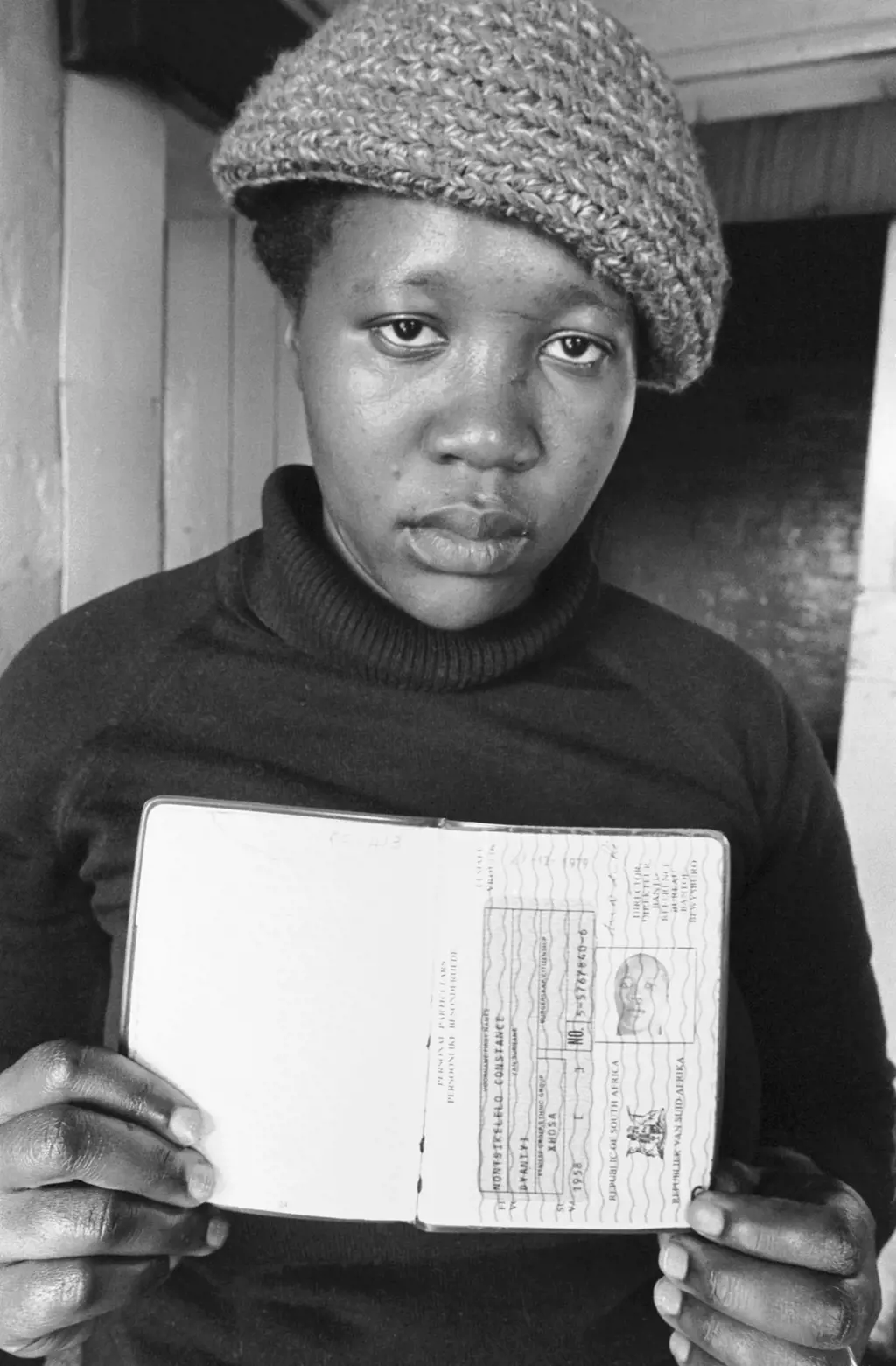
During the apartheid era in South Africa, the government implemented a series of restrictive measures that severely impacted the lives and mobility of non-white South Africans. These measures were aimed at segregating and controlling the non-white population, particularly black Africans, coloreds, and Indians.
One of the most significant restrictions was the pass law system, which required non-white individuals to carry a pass book at all times. This pass book contained personal information and details of their employment status. Without a valid pass, non-whites were not allowed to leave their designated areas or enter certain areas designated for white people. This restriction limited their mobility and made it impossible for non-whites to move freely within the country.
The pass laws also enforced residential segregation, known as forced removals. Non-white communities were forcefully relocated to designated areas called townships or homelands. These areas were often located far away from urban centers and lacked basic infrastructure and services. This resulted in overcrowded living conditions, limited access to education and healthcare, and restricted economic opportunities for non-whites.
Another restriction that impacted the lives of non-white South Africans was the Group Areas Act. This act enforced racial segregation in housing, education, and cultural facilities. Non-whites were not allowed to live in areas designated for white residents, and they were forced to live in designated townships or homelands. This restriction further entrenched racial inequality and limited non-white individuals' access to quality housing and amenities.
The government also implemented restrictions on education and employment opportunities for non-white individuals. The Bantu Education Act was introduced in 1953, which segregated education along racial lines. Non-white schools received less funding and resources compared to white schools, leading to substandard education for non-white students. This restriction limited their chances of pursuing higher education and obtaining skilled employment opportunities.
Furthermore, the government implemented the Reservation of Separate Amenities Act, which provided separate public facilities for different racial groups. Non-white individuals were not allowed to use facilities designated for white individuals, such as parks, beaches, and public transportation. This restriction further limited their access to public spaces and amenities, reinforcing racial segregation in all aspects of life.
The impact of these restrictions on the lives and mobility of non-white South Africans was significant. They were subjected to daily humiliation and harassment by authorities who enforced these laws. Non-white individuals faced severe consequences if they were found to be in violation of these restrictions, including arrest, imprisonment, or fines. The restrictions also created a sense of powerlessness, limiting their ability to challenge or protest against the oppressive apartheid regime.
Overall, these restrictions under apartheid severely impacted the lives and mobility of non-white South Africans. They created systemic racial segregation, limited access to basic services and amenities, and restricted educational and employment opportunities. These restrictions served to reinforce racial inequality and maintain white minority rule. It was not until the end of apartheid in 1994 that these restrictions were gradually dismantled, and non-white South Africans were able to regain their freedom and equality.
Understanding Air Travel Restrictions: Can You Bring Scissors on a Plane?
You may want to see also

Were there any exceptions or loopholes to these travel restrictions for certain groups or individuals?
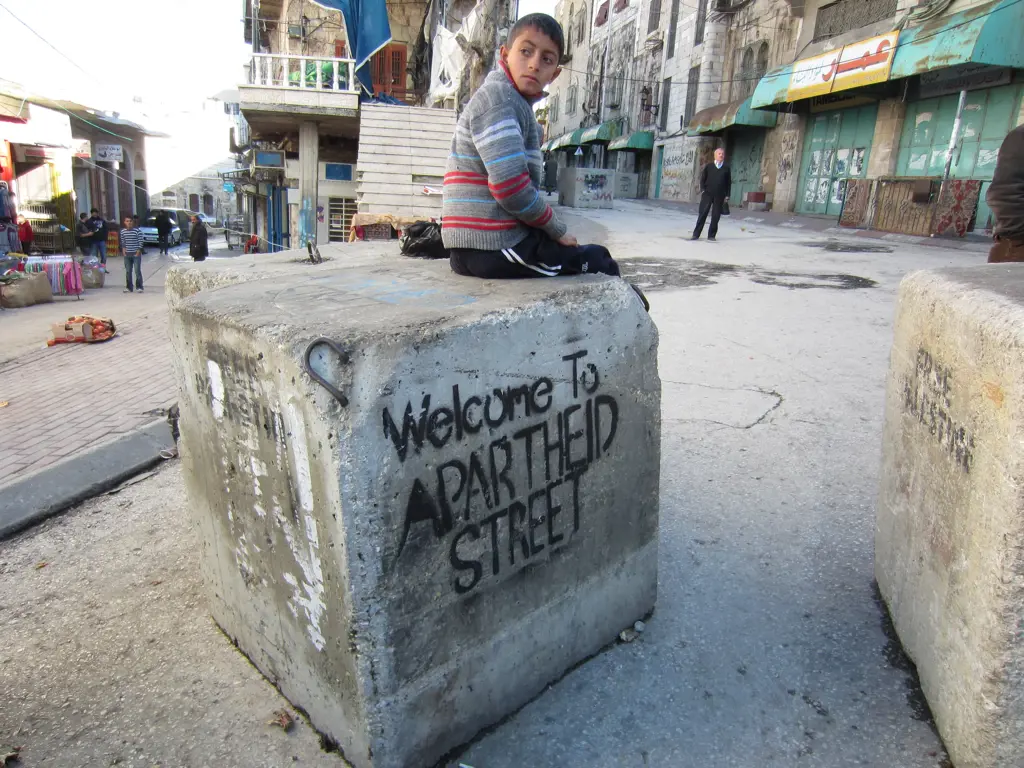
Travel restrictions during times of crisis or emergencies are often put in place to prevent the spread of disease or to control the movement of people. While these restrictions are generally applicable to all individuals, there are often exceptions or loopholes that allow certain groups or individuals to travel despite the restrictions.
One common exception to travel restrictions is the exemption for essential workers. During a crisis, there are certain workers who are designated as essential for the operation of critical services. These may include healthcare workers, emergency responders, and law enforcement personnel. These individuals are often exempt from travel restrictions to ensure that they can continue to perform their vital tasks.
Another common exception is for individuals who are traveling for urgent medical reasons. In some cases, people may need to travel to receive specialized medical treatment or to access essential healthcare services. These individuals may be granted an exemption from travel restrictions to ensure that they can receive the necessary care.
Additionally, there may be exceptions for individuals who are traveling for humanitarian reasons. This may include individuals involved in relief efforts or providing essential aid to affected areas. These individuals may be exempt from travel restrictions to allow them to provide assistance to those in need.
In some cases, individuals who have a compelling reason to travel may be able to apply for a special permit or waiver. This may be granted on a case-by-case basis and may require documentation or proof of the compelling reason.
It is important to note that while these exceptions and loopholes exist, they are typically implemented with strict guidelines and oversight to ensure that they are not abused. Governments and authorities responsible for implementing travel restrictions closely monitor and regulate the use of these exceptions to ensure that they are being applied appropriately.
During times of crisis or emergencies, travel restrictions can play a crucial role in controlling the spread of disease and protecting public health. However, it is also important to recognize that certain individuals or groups may have legitimate reasons for needing to travel despite these restrictions. The exceptions and loopholes in place aim to balance the need for control with the recognition of these unique circumstances.
Exploring Okinawa: Navigating the Travel Restrictions in Japan's Island Paradise
You may want to see also

How did international tourism react to the travel restrictions during apartheid in South Africa?
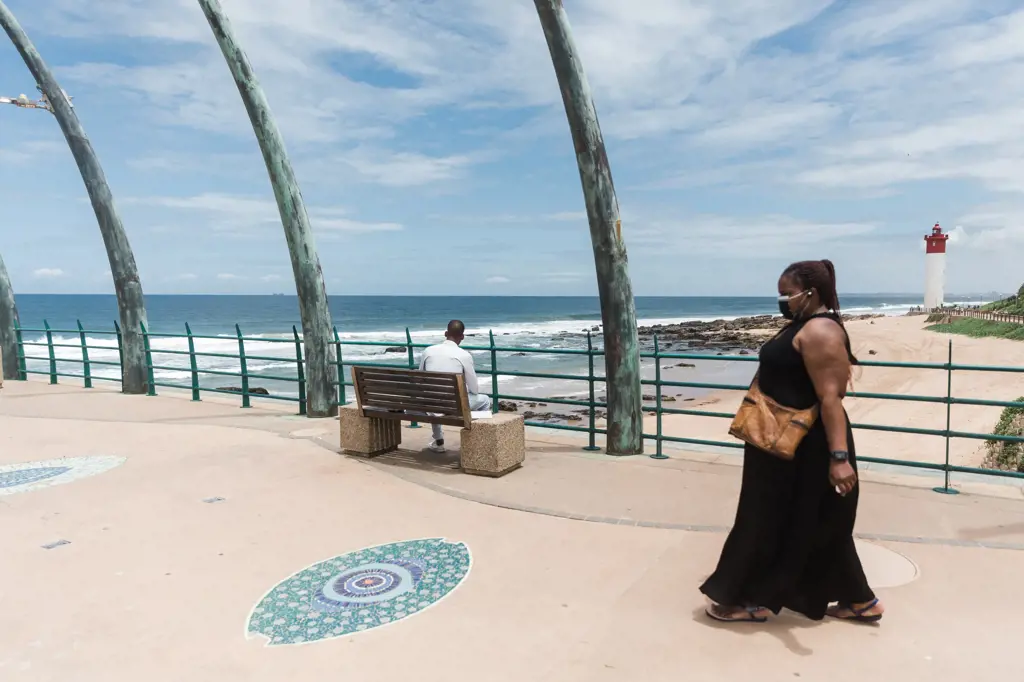
International tourism had a complicated relationship with South Africa during the years of apartheid. Apartheid was a system of racial segregation and discrimination enforced by the South African government from 1948 to 1994. The policies and practices of apartheid led to widespread condemnation and protests from the international community, including in the tourism sector.
During apartheid, South Africa was largely isolated from the international community due to travel restrictions imposed by various countries and international organizations. Many countries implemented travel bans and economic sanctions against South Africa in protest against the apartheid regime. These restrictions had a significant impact on the tourism industry in the country.
The travel restrictions meant that South Africa was effectively cut off from many lucrative international tourism markets. Tourists from countries that had imposed travel bans were discouraged from visiting the country, while international tourism organizations and operators faced pressure to boycott South Africa. This had a direct and negative impact on the South African economy, as tourism was an important source of revenue and employment.
However, despite the travel restrictions, there were still tourists who chose to visit South Africa during apartheid, albeit in smaller numbers. These tourists were often motivated by various factors, including curiosity about the country's history and culture, or a desire to witness the anti-apartheid struggle firsthand. Some tourists also defied the travel bans and restrictions, risking legal consequences to visit South Africa and support the anti-apartheid movement.
South Africa's tourism industry also adapted to the challenging circumstances during apartheid. The country promoted domestic tourism to make up for the decline in international visitors. Local tourism campaigns targeted South African residents and encouraged them to explore their own country. This helped to sustain some level of tourist activity and support the local economy.
The international tourism industry itself was divided in its response to the travel restrictions during apartheid. Some organizations and operators chose to abide by the sanctions and refuse to offer tours or promote South Africa as a destination. Others took a different approach, arguing that engagement and dialogue through tourism could be a positive force for change and transformation in the country. They believed that by interacting with local communities and supporting responsible tourism practices, tourists could contribute to economic development and social progress.
It is important to note that the impact of travel restrictions on international tourism during apartheid was not uniform. Some countries and regions were more resistant to implementing travel bans, while others were more vocal in their opposition to the apartheid regime. The situation also evolved over time, with the international community increasing its pressure on South Africa as the anti-apartheid movement gained momentum.
In conclusion, international tourism during the years of apartheid in South Africa faced significant challenges due to travel restrictions and sanctions imposed by various countries and organizations. The travel bans had a negative impact on the South African economy, but there were still tourists who chose to visit the country, motivated by different reasons. The tourism industry adapted by promoting domestic tourism and some operators engaged in responsible tourism practices. The international tourism community itself was divided in its response to the travel restrictions, with some organizations supporting the sanctions and others advocating for engagement and dialogue through tourism.
Understanding the Current Singapore Travel Restrictions for US Visitors: What You Need to Know
You may want to see also

Is there any evidence to suggest that the travel restrictions during apartheid were effective in achieving their intended goals?
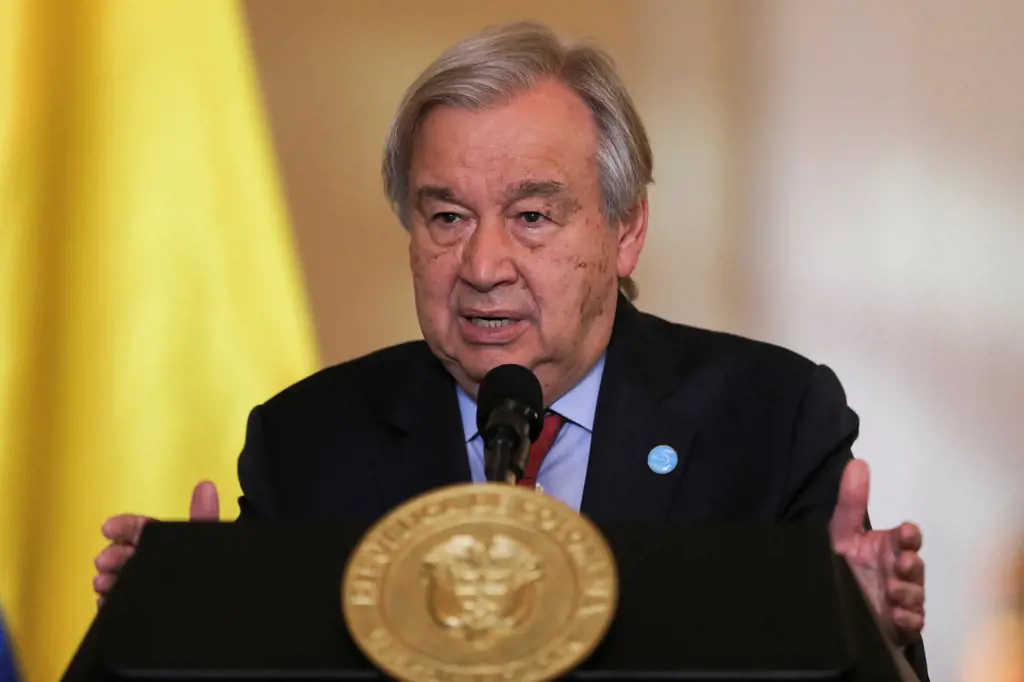
The travel restrictions implemented during apartheid in South Africa were part of a broader system of racial segregation and control. These restrictions aimed to separate and marginalize different racial groups, particularly black South Africans, and maintain the dominance and power of the white minority.
There is evidence to suggest that these travel restrictions were effective in achieving their intended goals, but it is important to acknowledge the immense human suffering and violations of basic human rights that accompanied them.
One of the key objectives of the travel restrictions was to limit the movements and opportunities of black South Africans. The government implemented a system of pass laws, which required non-white individuals to carry identification documents and obtain permits to reside or travel in certain areas. These pass laws effectively restricted the ability of black South Africans to move freely within South Africa and limited their access to education, employment opportunities, and basic services.
The pass laws also aimed to control the allocation of labor in South Africa. By restricting the movement of black individuals, the government sought to ensure a steady supply of cheap labor for white-owned industries. This helped maintain the economic power and prosperity of the white minority.
Additionally, the travel restrictions were part of a broader system of segregation and control that aimed to enforce racial separation. The apartheid government believed in the notion of separate development, which sought to create distinct racial homelands and keep different racial groups physically separated. The travel restrictions played a crucial role in enforcing this policy by preventing or limiting cross-racial interactions and movements.
However, it is important to note that the effectiveness of the travel restrictions should not be equated with their morality or legitimacy. The implementation of the pass laws and travel restrictions resulted in widespread protests, resistance, and human rights abuses. Countless black South Africans were arrested, jailed, and subjected to violent or degrading treatment for simply attempting to defy these restrictions and assert their basic rights.
Furthermore, the travel restrictions were met with international condemnation and played a significant role in isolating South Africa on the global stage. Numerous countries and international organizations implemented economic sanctions and boycotts to protest the apartheid regime, highlighting the inequities and injustices perpetuated by the travel restrictions.
In conclusion, there is evidence to suggest that the travel restrictions implemented during apartheid were effective in achieving their intended goals of maintaining racial segregation and control. However, it is essential to recognize that these restrictions also resulted in severe human rights violations and contributed to the isolation and condemnation of the apartheid regime. The legacies of these travel restrictions continue to be felt in South Africa today, as the country grapples with the ongoing struggle for social justice and equality.
The Impact of Travel Restrictions on the Tourism Industry: A Comprehensive Analysis
You may want to see also
Frequently asked questions
During apartheid, the South African government implemented strict travel restrictions that segregated people based on their racial classification. The Population Registration Act of 1950 required all South Africans to carry a passbook or reference book at all times, which indicated their racial classification and allowed them to move freely within certain areas designated for their respective racial group. Non-white South Africans, especially black Africans, faced severe restrictions on where they could live and work, as well as limited access to education and public facilities.
The travel restrictions during apartheid had a profound impact on black Africans. These restrictions severely limited their freedom of movement and made it extremely difficult for them to access educational opportunities, find employment outside of designated "black" areas, and visit family members living in other regions of the country. Black Africans were subjected to constant harassment and arbitrary arrests if they were found to be traveling without valid permits or outside of designated areas, leading to further marginalization and discrimination.
Yes, travel restrictions were not only enforced at the borders but also within the country itself. Non-white South Africans were required to obtain permits or passes to travel to certain areas designated for specific racial groups. This internal passport system severely limited the mobility of black Africans and created separate and unequal living conditions based on race.
While there were limited exceptions to the travel restrictions, they were mainly granted to individuals who were deemed necessary for the functioning of the apartheid system. For example, black Africans who worked as migrant laborers in white-owned industries were granted temporary permits to travel to work. However, these permits were only valid for specific periods and often required individuals to live in overcrowded and substandard hostels.
The travel restrictions were gradually lifted in the early 1990s as South Africa transitioned away from apartheid towards democracy. Political pressure, both domestically and internationally, played a significant role in bringing about these changes. In 1991, the South African government repealed the pass laws, marking a significant step towards dismantling the apartheid system. The lifting of travel restrictions allowed for greater mobility and equality for all South Africans, regardless of race.


